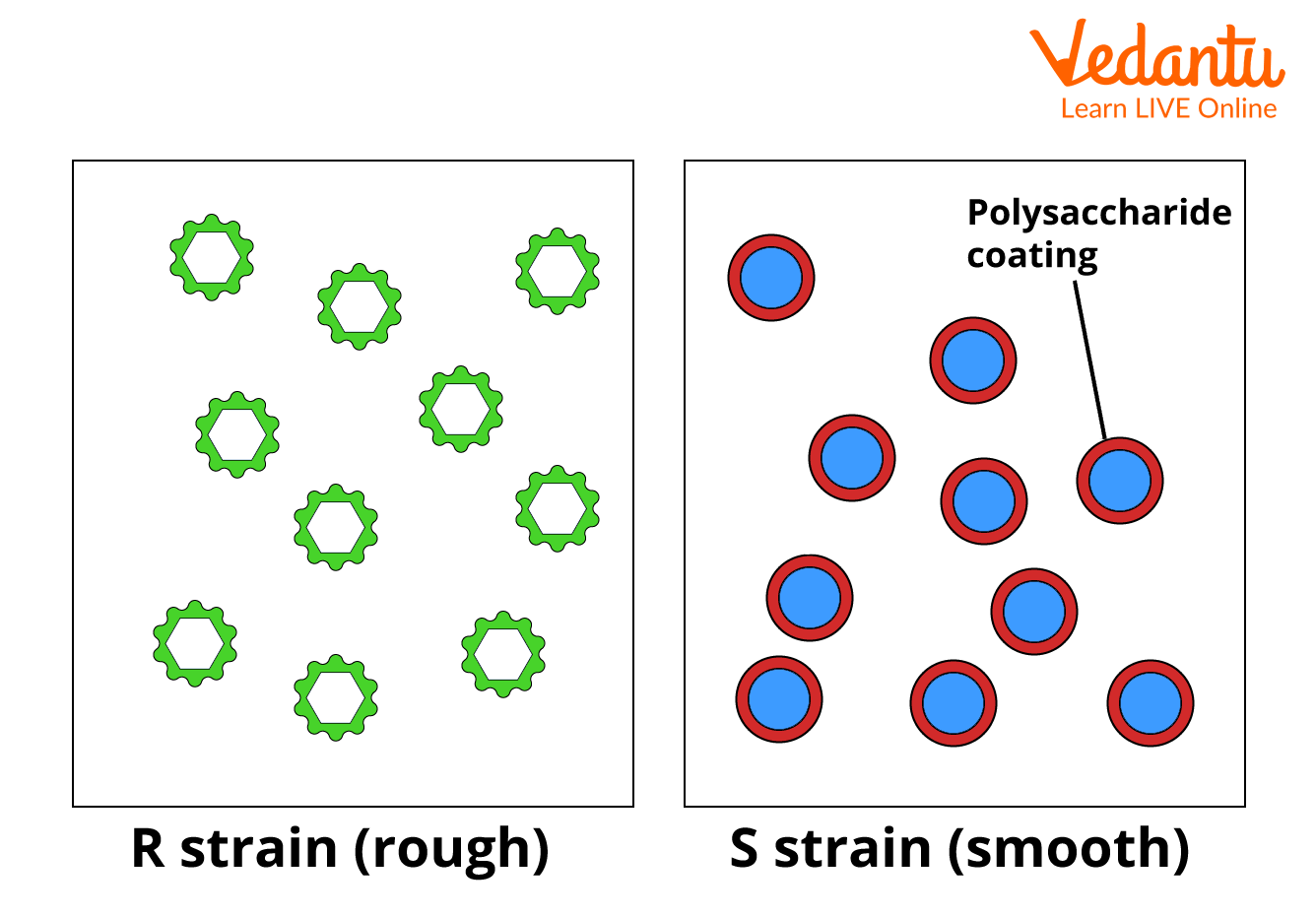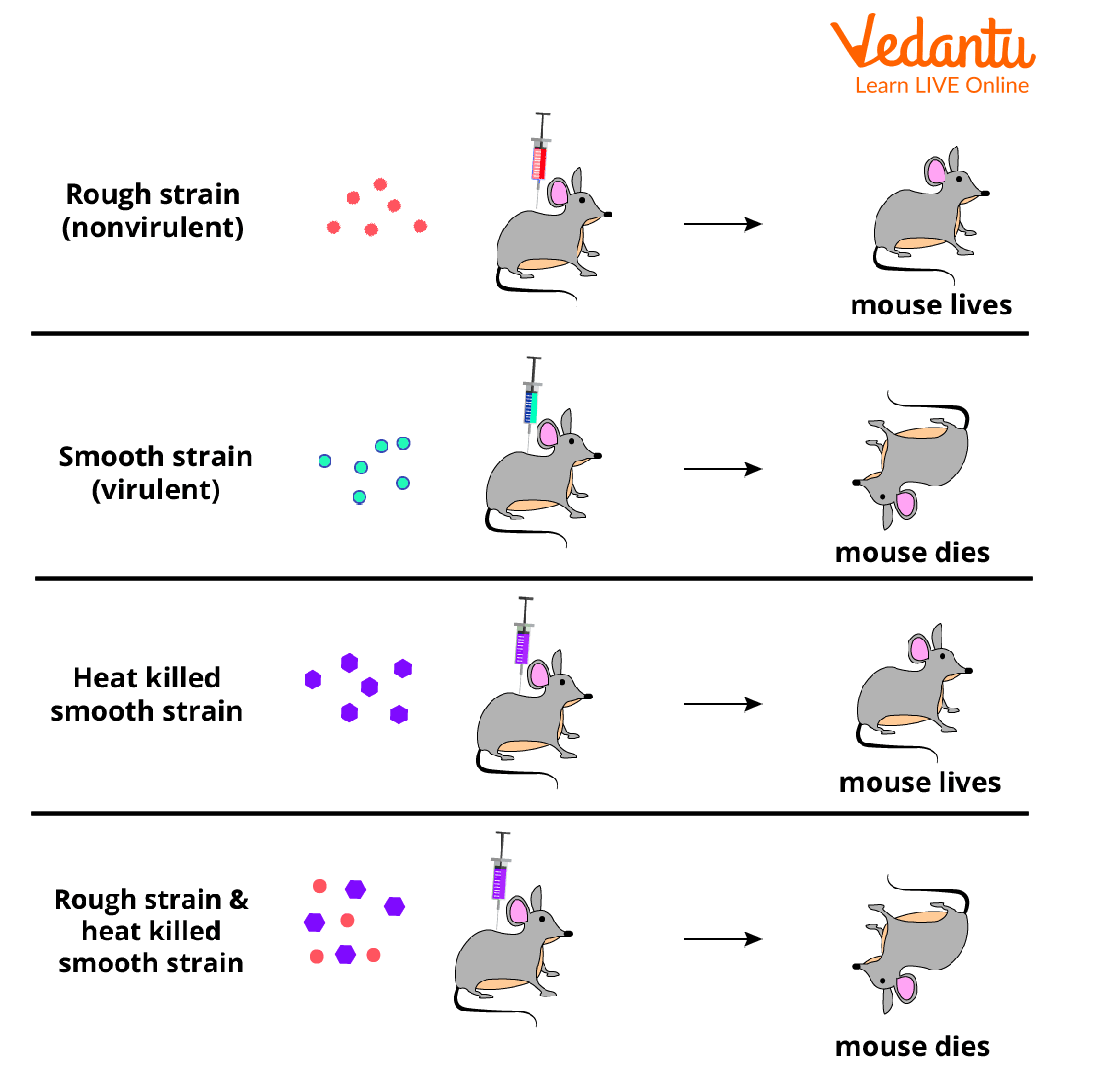What Were the Key Steps and Outcome of the Griffith Experiment?
The Griffith Experiment is a landmark study in genetics that revealed how bacteria could acquire new traits. Conducted in 1928 by Frederick Griffith, this experiment set the stage for understanding DNA's role in heredity. It remains a foundational topic for students preparing for NEET, CBSE, and other biology exams, as well as those exploring biotechnology and molecular biology.
Griffith Experiment: Definition and Historical Significance
Griffith Experiment definition: It refers to Frederick Griffith’s 1928 research that showed nonvirulent bacteria could transform into virulent forms by absorbing genetic materials from dead bacteria. This discovery of a “transforming principle” led to the understanding that DNA carries genetic information, revolutionizing genetics and molecular biology.
The findings were a turning point for the study of heredity. The Griffith Experiment influenced later research by Avery, MacLeod, and McCarty, who identified DNA as the genetic material. Today, this concept supports advances such as genetic engineering and disease research, highlighting the importance of transformation in biology.
R and S Strains of Streptococcus pneumoniae
In the Griffith Experiment, two forms of the bacterium Streptococcus pneumoniae were used: the S (Smooth) strain and the R (Rough) strain. Both played crucial roles in demonstrating genetic transformation.

| Term | Description |
|---|---|
| S Strain (Smooth) | Capsulated, virulent; causes pneumonia in mice |
| R Strain (Rough) | Non-capsulated, nonvirulent; does not cause disease |
| Transforming Principle | Unknown molecule (later found to be DNA) that transfers genetic traits |
The capsule on S strain bacteria makes them smooth and able to evade the immune system, while the R strain lacks this capsule, appearing rough and non-virulent. Understanding the difference is vital for interpreting the Griffith Experiment and for learning about bacterial genetics and disease mechanisms.
Steps of the Griffith Experiment
The Griffith Experiment followed a logical sequence, using mice to observe the effects of different bacterial strains. These steps provided conclusive evidence for the existence of a transforming principle, marking a major step forward in genetics.
- Injection 1: Live R Strain – Griffith injected mice with the live R (Rough) strain. The mice survived, as these bacteria are nonvirulent.
- Injection 2: Live S Strain – Mice injected with the live S (Smooth) strain died because this strain is virulent.
- Injection 3: Heat-killed S Strain – Griffith injected mice with S strain bacteria that had been killed with heat. The mice lived, showing that dead S strain could not cause disease.
- Injection 4: Live R Strain + Heat-killed S Strain – Mice received both live R strain and heat-killed S strain. To Griffith’s surprise, these mice died, and live S strain bacteria were recovered from their blood.
These observations suggested that a substance from the dead S strain had transformed the nonvirulent R strain bacteria into virulent S strain, providing direct evidence for genetic transformation.
Griffith Experiment Diagram: Steps and Key Results

This diagram visually demonstrates the essential logic of the experiment, showing the outcomes of each bacterial injection in mice. Notice how only the combination of live R strain and dead S strain led to the transformation and death of the mice, confirming the presence of a transforming principle.
Scientific Importance and Griffith Experiment Explanation
The Griffith Experiment proved that hereditary information can transfer between organisms. The ability of heat-killed S strain to transform R strain into a virulent form introduced the concept of bacterial transformation, which is now a fundamental technique in genetic engineering and molecular biology.
Later experiments by Avery, MacLeod, and McCarty identified the transforming principle as DNA. This finding supports our modern understanding of genetics, inheritance, and the chemical basis of life. Today, concepts from this experiment guide applications in medicine, agriculture, vaccine development, and disease treatment. You can explore differences between acquired and inherited traits to connect these ideas further.
Applications and Relevance of the Griffith Experiment
The impact of Griffith's work is seen in many fields:
- Genetic engineering: The discovery of transformation led to bacterial gene transfer in biotechnology.
- Medicine: Understanding how genetic material moves helps in vaccine research and gene therapy.
- Agriculture: Techniques based on transformation are used to create disease-resistant crops.
- Biochemistry: The experiment paved the way for studying biomolecules, including DNA and its function in cells.
With modern advances, scientists use transformation for gene cloning, recombinant DNA technology, and producing medicines like insulin. For more on the biochemical basis of life, try our topic What are Biomolecules.
Comparison: Transformation, Transduction, and Conjugation
The Griffith Experiment demonstrates transformation, but bacteria exchange genetic material through other processes too. It’s important to distinguish these concepts in bacterial genetics:
- Transformation: Direct uptake and incorporation of naked DNA from the environment. (As shown in the Griffith Experiment.)
- Transduction: Genetic material is transferred using a bacteriophage (virus).
- Conjugation: DNA is transferred from one bacterium to another by cell-to-cell contact, often via a pilus structure.
Understanding these differences helps clarify how bacteria adapt and evolve rapidly, affecting fields from medicine to environmental science. For more about genetic inheritance, see our page on Cell Theory.
Examples and Short Notes on the Griffith Experiment
Here are concise notes and real-world examples to reinforce your learning:
- Griffith Experiment example: A non-pathogenic (R strain) bacterium absorbs DNA from a heat-killed pathogenic (S strain) bacterium. The R strain becomes pathogenic.
- Uses: Transformation techniques are used in laboratories to introduce new genes into bacteria, for making medicines and studying gene function.
- Applications in NEET/CBSE exams: The experiment is a favorite for MCQs and short note questions, especially about the scientific history of genetics.
- Summary: The key finding is that DNA (not protein or carbohydrates) is the molecule of heredity. This forms the foundation of molecular biology courses.
To explore more MCQs and applications, check out related topics on bacterial genetics and biotechnology within Vedantu’s biology section.
Page Summary
The Griffith Experiment is central to understanding genetic transformation and the role of DNA in heredity. Its insights underpin today’s biotechnology, disease research, and exam preparation. By learning the concept, procedure, and applications, students build a strong base in genetics, which supports success in advanced biology and real-world innovations.


FAQs on Griffith Experiment: Simple Explanation and Inference
1. What was the Griffith experiment and why is it important in genetics?
The Griffith experiment demonstrated the phenomenon of bacterial transformation and showed that genetic material can be transferred from one bacterium to another.
Key points:
- Conducted by Frederick Griffith in 1928
- Involved two strains of Streptococcus pneumoniae bacteria (smooth/S and rough/R)
- Proved the existence of a transforming principle (later identified as DNA)
- Laid the foundation for discovering that DNA is the genetic material
2. What is the principle of transformation as discovered by Griffith?
The principle of transformation refers to the ability of certain substances to transfer genetic traits from one cell to another.
Main concepts:
- Heat-killed smooth (S) strain bacteria, when mixed with live rough (R) strain, transformed R strain into virulent S strain
- Transformation transfered genetic information that changed phenotype
- This discovery was a milestone toward proving that DNA is responsible for heredity
3. What were the steps involved in the Griffith experiment?
The Griffith experiment followed a series of steps to test bacterial transformation.
Steps:
- Injected live S strain (virulent) into mice – mice died
- Injected live R strain (non-virulent) into mice – mice lived
- Injected heat-killed S strain into mice – mice lived
- Injected a mixture of heat-killed S strain and live R strain – mice died
4. Which organisms and strains were used in the Griffith experiment?
Griffith used two strains of Streptococcus pneumoniae bacteria:
- The S (smooth) strain – virulent due to a polysaccharide capsule, causing disease
- The R (rough) strain – non-virulent, lacking the capsule, non-pathogenic
5. What was the conclusion of Griffith's experiment?
Griffith concluded that a transforming principle from the dead S strain could make the R strain virulent.
Key takeaways:
- Genetic information can be transferred horizontally between bacteria
- Provided evidence of a physical basis for heredity
- Allowed future scientists to identify DNA as the genetic material
6. How did Griffith's experiment contribute to the discovery of DNA as genetic material?
Griffith's work led scientists to investigate the chemical nature of genetic material.
- Inspired further research by Avery, MacLeod, and McCarty
- Paved the way to prove that DNA, not protein, is the hereditary material
- Initiated the molecular era in genetics
7. What experiment followed Griffith’s to confirm the transforming principle was DNA?
The Avery, MacLeod, and McCarty experiment (1944) confirmed DNA as the transforming principle.
Main points:
- They purified DNA, proteins, and RNA from S cells
- Only DNA was able to transform R strain into S strain
- This provided strong proof that DNA is the hereditary material
8. Why did mice die when injected with heat-killed S strain and live R strain together?
Mice died because the live R strain bacteria absorbed the genetic material from the heat-killed S strain, transforming into virulent S type.
Explanation:
- Transformation allowed harmless R cells to produce a capsule
- Resulted in the disease-causing (virulent) phenotype
- Proved the transfer of genetic information
9. List the key differences between the S and R strains used in the Griffith experiment.
The S and R strains differ mainly in their virulence and capsule presence.
Differences:
- S Strain: Has a polysaccharide capsule, smooth appearance, virulent
- R Strain: Lacks capsule, rough appearance, non-virulent
10. What is the significance of the Griffith experiment for modern biology?
The Griffith experiment is significant because it introduced the concept of genetic transformation.
Importance:
- First demonstration of spontaneous gene transfer in bacteria
- Basis for genetic engineering and biotechnology
- Led to identification of DNA as the molecule of heredity










